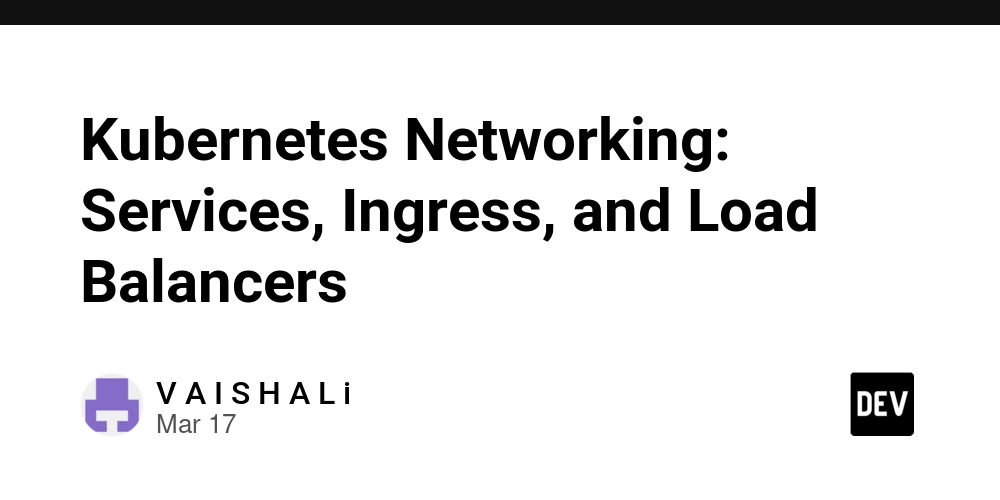Kubernetes Networking: Services, Ingress, and Load Balancers
Kubernetes networking is a fundamental aspect of managing and scaling applications effectively. Understanding Services, Ingress, and Load Balancers helps in ensuring seamless communication between pods, exposing applications to the outside world, and managing traffic efficiently. This blog post explores these concepts in depth, drawing insights from Drew's Kubernetes networking series. 1. Why Kubernetes Networking is Used In traditional infrastructure, networking can be complex due to manual configurations, IP management, and dependency on static environments. Kubernetes abstracts these complexities by providing dynamic service discovery, load balancing, and seamless communication between microservices. Kubernetes networking is used to: Ensure reliable communication between microservices across different nodes. Enable external access to applications with controlled traffic management. Support scalability by dynamically routing traffic to healthy pods. Facilitate security through network policies, ingress rules, and TLS encryption. 2. Kubernetes Networking Basics Kubernetes provides a flat, cluster-wide network model, ensuring that every pod can communicate with other pods regardless of the node they reside on. However, Kubernetes networking does not manage external access by default, which is where Services, Ingress, and Load Balancers come into play. 3. Kubernetes Services A Service in Kubernetes is an abstraction that defines a logical set of pods and a policy for accessing them. Since pods are ephemeral and have dynamic IPs, services provide a stable endpoint for communication. Types of Services: ClusterIP (Default): Exposes the service on an internal IP within the cluster, making it accessible only from within Kubernetes. NodePort: Exposes the service on each node’s IP at a static port, allowing external access. LoadBalancer: Provisions an external load balancer (on cloud providers) to expose the service. ExternalName: Maps the service to an external DNS name, useful for redirecting requests outside the cluster. Example YAML for a ClusterIP Service: apiVersion: v1 kind: Service metadata: name: my-service spec: selector: app: my-app ports: - protocol: TCP port: 80 targetPort: 8080 This configuration routes requests from port 80 to the target port 8080 of the associated pods. Real-World Use Case for Services E-commerce Platform: In an e-commerce application, different microservices such as payment, inventory, and user authentication need stable connectivity. Kubernetes Services ensure these microservices can reliably communicate with each other, even as pods scale up and down. 4. Ingress: Managing External Access While Services expose applications, they do not provide flexible traffic routing or domain-based access. This is where Ingress comes in. What is Ingress? Ingress is an API object that manages external access, typically HTTP/HTTPS, to services within a cluster. It provides capabilities like: Path-based routing (e.g., example.com/app1 → Service A, example.com/app2 → Service B) Name-based virtual hosting SSL/TLS termination Load balancing Example YAML for an Ingress Resource: apiVersion: networking.k8s.io/v1 kind: Ingress metadata: name: my-ingress spec: rules: - host: example.com http: paths: - path: /app pathType: Prefix backend: service: name: my-service port: number: 80 This Ingress routes traffic from example.com/app to my-service on port 80. Real-World Use Case for Ingress Multi-Tenant SaaS Application: A SaaS platform serving multiple clients under different domains (client1.example.com, client2.example.com) can use Kubernetes Ingress to route traffic to the correct backend service based on the requested domain. Ingress Controllers Ingress requires an Ingress Controller (e.g., Nginx Ingress Controller, Traefik, HAProxy) to function. These controllers watch for Ingress resources and update their routing configurations accordingly. 5. Load Balancers: Scaling Traffic Efficiently A Load Balancer distributes network traffic across multiple backend instances to ensure high availability and reliability. Kubernetes LoadBalancer Service On cloud environments (AWS, GCP, Azure), Kubernetes automatically provisions an external load balancer when you define a LoadBalancer type service. Example YAML for a LoadBalancer Service: apiVersion: v1 kind: Service metadata: name: my-loadbalancer-service spec: type: LoadBalancer selector: app: my-app ports: - protocol: TCP port: 80 targetPort: 8080 In on-premise clusters, tools like MetalLB can be used to enable LoadBalancer functionality. Real-World Use Case for Load Balancers Streaming Platform: A video streaming service like YouTube or Netflix requires efficient traffic distribution to handle millions of co

Kubernetes networking is a fundamental aspect of managing and scaling applications effectively. Understanding Services, Ingress, and Load Balancers helps in ensuring seamless communication between pods, exposing applications to the outside world, and managing traffic efficiently.
This blog post explores these concepts in depth, drawing insights from Drew's Kubernetes networking series.
1. Why Kubernetes Networking is Used
In traditional infrastructure, networking can be complex due to manual configurations, IP management, and dependency on static environments. Kubernetes abstracts these complexities by providing dynamic service discovery, load balancing, and seamless communication between microservices. Kubernetes networking is used to:
Ensure reliable communication between microservices across different nodes.
Enable external access to applications with controlled traffic management.
Support scalability by dynamically routing traffic to healthy pods.
Facilitate security through network policies, ingress rules, and TLS encryption.
2. Kubernetes Networking Basics
Kubernetes provides a flat, cluster-wide network model, ensuring that every pod can communicate with other pods regardless of the node they reside on. However, Kubernetes networking does not manage external access by default, which is where Services, Ingress, and Load Balancers come into play.
3. Kubernetes Services
A Service in Kubernetes is an abstraction that defines a logical set of pods and a policy for accessing them. Since pods are ephemeral and have dynamic IPs, services provide a stable endpoint for communication.
Types of Services:
ClusterIP (Default): Exposes the service on an internal IP within the cluster, making it accessible only from within Kubernetes.
NodePort: Exposes the service on each node’s IP at a static port, allowing external access.
LoadBalancer: Provisions an external load balancer (on cloud providers) to expose the service.
ExternalName: Maps the service to an external DNS name, useful for redirecting requests outside the cluster.
Example YAML for a ClusterIP Service:
apiVersion: v1
kind: Service
metadata:
name: my-service
spec:
selector:
app: my-app
ports:
- protocol: TCP
port: 80
targetPort: 8080
This configuration routes requests from port 80 to the target port 8080 of the associated pods.
Real-World Use Case for Services
E-commerce Platform: In an e-commerce application, different microservices such as payment, inventory, and user authentication need stable connectivity. Kubernetes Services ensure these microservices can reliably communicate with each other, even as pods scale up and down.
4. Ingress: Managing External Access
While Services expose applications, they do not provide flexible traffic routing or domain-based access. This is where Ingress comes in.
What is Ingress?
Ingress is an API object that manages external access, typically HTTP/HTTPS, to services within a cluster. It provides capabilities like:
Path-based routing (e.g., example.com/app1 → Service A, example.com/app2 → Service B)
Name-based virtual hosting
SSL/TLS termination
Load balancing
Example YAML for an Ingress Resource:
apiVersion: networking.k8s.io/v1
kind: Ingress
metadata:
name: my-ingress
spec:
rules:
- host: example.com
http:
paths:
- path: /app
pathType: Prefix
backend:
service:
name: my-service
port:
number: 80
This Ingress routes traffic from example.com/app to my-service on port 80.
Real-World Use Case for Ingress
Multi-Tenant SaaS Application: A SaaS platform serving multiple clients under different domains (client1.example.com, client2.example.com) can use Kubernetes Ingress to route traffic to the correct backend service based on the requested domain.
Ingress Controllers
Ingress requires an Ingress Controller (e.g., Nginx Ingress Controller, Traefik, HAProxy) to function. These controllers watch for Ingress resources and update their routing configurations accordingly.
5. Load Balancers: Scaling Traffic Efficiently
A Load Balancer distributes network traffic across multiple backend instances to ensure high availability and reliability.
Kubernetes LoadBalancer Service
On cloud environments (AWS, GCP, Azure), Kubernetes automatically provisions an external load balancer when you define a LoadBalancer type service.
Example YAML for a LoadBalancer Service:
apiVersion: v1
kind: Service
metadata:
name: my-loadbalancer-service
spec:
type: LoadBalancer
selector:
app: my-app
ports:
- protocol: TCP
port: 80
targetPort: 8080
In on-premise clusters, tools like MetalLB can be used to enable LoadBalancer functionality.
Real-World Use Case for Load Balancers
Streaming Platform: A video streaming service like YouTube or Netflix requires efficient traffic distribution to handle millions of concurrent users. Kubernetes Load Balancers ensure that incoming requests are evenly distributed across multiple backend instances to prevent overload.
6. Choosing the Right Networking Strategy
Use Case
Internal pod-to-pod communication
External access to a single service
Load balancing across multiple backends
Routing traffic based on domain/path
Best Option
ClusterIP Service
NodePort or LoadBalancer Service
Ingress with an Ingress Controller
LoadBalancer or Ingress
Conclusion
Understanding Kubernetes networking through Services, Ingress, and Load Balancers is key to efficiently managing traffic and exposing applications. Services handle internal and external connectivity, Ingress provides advanced traffic management, and Load Balancers ensure scalability. By implementing these effectively, you can optimize the availability and reliability of your Kubernetes workloads.











































































































































































![[The AI Show Episode 142]: ChatGPT’s New Image Generator, Studio Ghibli Craze and Backlash, Gemini 2.5, OpenAI Academy, 4o Updates, Vibe Marketing & xAI Acquires X](https://www.marketingaiinstitute.com/hubfs/ep%20142%20cover.png)


























































































































![[FREE EBOOKS] The Kubernetes Bible, The Ultimate Linux Shell Scripting Guide & Four More Best Selling Titles](https://www.javacodegeeks.com/wp-content/uploads/2012/12/jcg-logo.jpg)



![From drop-out to software architect with Jason Lengstorf [Podcast #167]](https://cdn.hashnode.com/res/hashnode/image/upload/v1743796461357/f3d19cd7-e6f5-4d7c-8bfc-eb974bc8da68.png?#)







































































































.png?#)




.jpg?#)
































_Christophe_Coat_Alamy.jpg?#)






































































































![Rapidus in Talks With Apple as It Accelerates Toward 2nm Chip Production [Report]](https://www.iclarified.com/images/news/96937/96937/96937-640.jpg)









































































































































